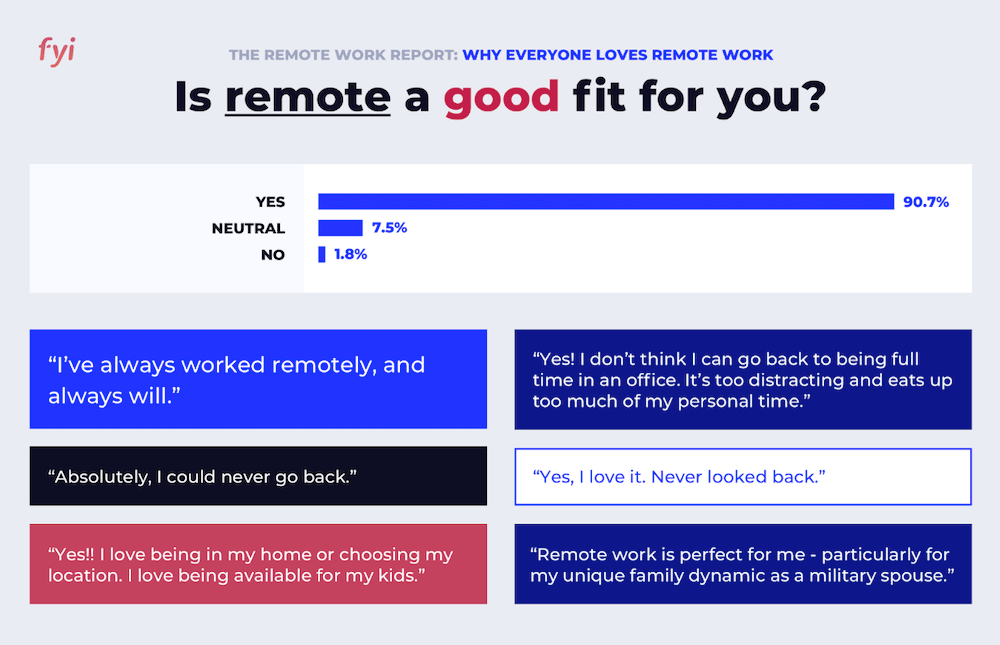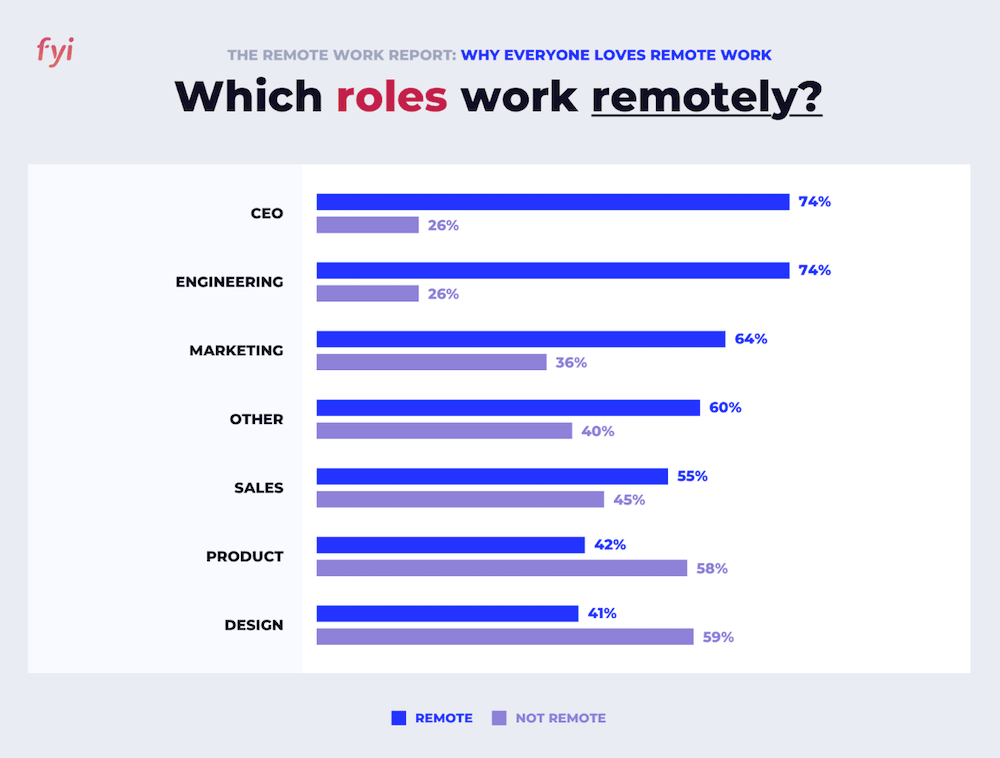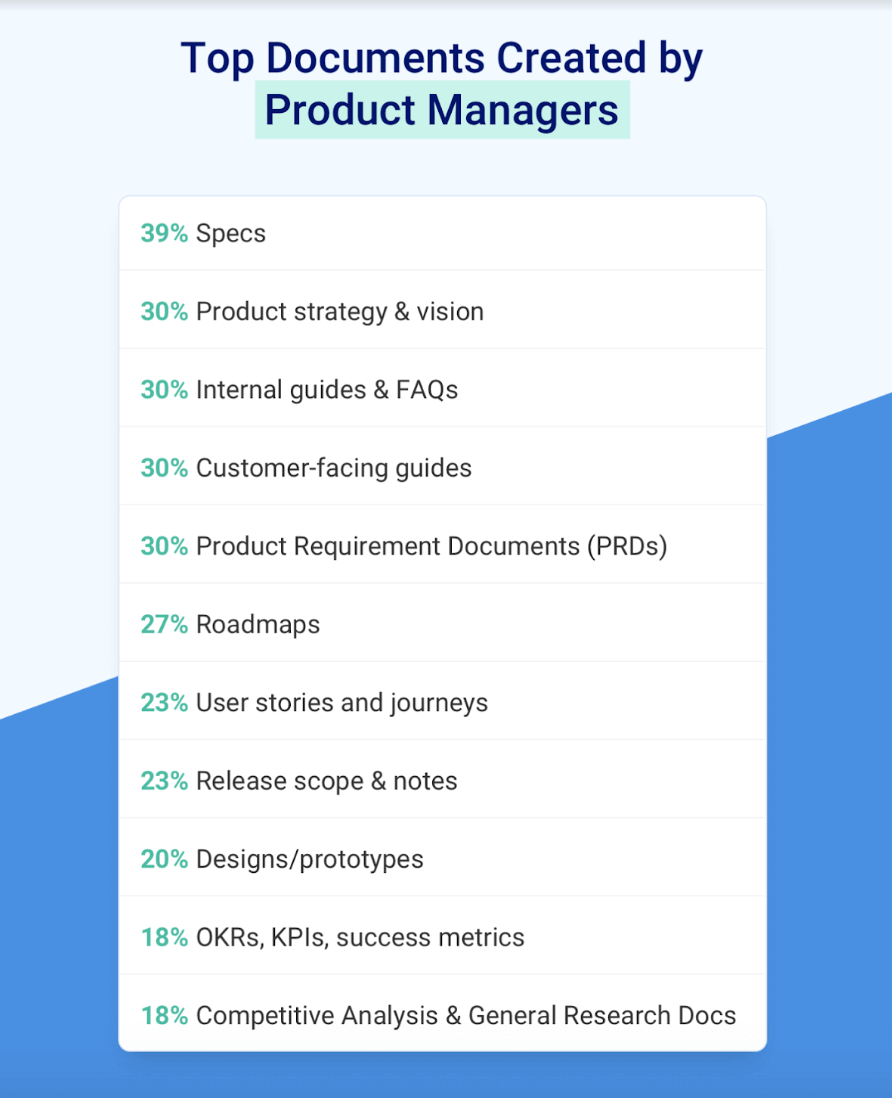A lone engineer codes feverishly in a dimly-lit room, drinking a caffeinated beverage and typing until their hands hurt. That dimly-lit room is located in their home, the perfect environment for writing code.
That’s probably what you’d see if I asked you to visualize what an engineer looks like at work. Either that or someone in an office working independently on code.
Now, imagine what a product person looks like at work.
Sticky notes carefully arranged and rearranged on a wall. Whiteboarding sessions. Cross-functional meetings discussing customer feedback. Presentations to senior stakeholders. Creative eureka moments shared with others in the room.
One of these jobs lends itself to remote work. But does the other?
Remote work, that is, working from home, coffee shops, coworking spaces, and anywhere that isn’t a traditional office, has grown tremendously over the last few years.
According to a 2018 Upwork study, 63% of US companies now have remote workers. Gallup’s State of the American Workplace Report had similar findings: 43% of employees now work remotely at least some of the time.
AngelList, home to thousands of job postings for remote and non-remote roles, is seeing growth in remote job listings. Nearly 30% of all startups with roles posted on AngelList as of August 2019 were hiring for remote roles. The company even hired a person dedicated to leading their corporate efforts around remote work.
And this is just the beginning. We’re likely to see even more roles moving to remote.
At my company, FYI, we surveyed 486 people about remote work and learned that people absolutely love working remotely.
Ninety-one percent of people who work remotely 100% of the time said that working remotely is a good fit for them. And 96% of them would recommend remote work to a friend.
With so much love for remote, media attention on the category, and tools like Slack and G Suite supporting remote work, it’s likely that there will be even more remote roles and companies moving to a fully or partially remote work model.
But where does that leave product?
Can Product Work Be Done Remotely?
Remember that image of a product person and their accouterments? Whiteboard, sticky notes, people? Well, it’s not far from the truth.
Although there are some people in product who work remotely 100% of the time, working remotely is not the norm for product. Based on our Remote Work Report, product has a lower percentage of remote workers than almost every other category of role in a company. CEOs, engineering, marketing, and sales all have more people working remotely. That leaves product and design with the fewest.
We Work Remotely, the largest remote work community in the world, shared some data with us about the types of remote roles posted on their site. And that data points to just how uncommon remote product roles are today.
From 2013 to 2017, there were no product roles posted on WWR.
2018 was the first year that WWR had product roles listed on their site. In that year, product made up just 1% of posted roles. Programming roles, on the other hand, made up 50% of the jobs posted on WWR in 2018.
But it’s not all doom and gloom for product roles going remote. The number of product roles posted on WWR is growing. As of the end of July 2019, product roles made up nearly 3% of roles listed on WWR in that same time period. That’s more than double the percentage in 2018, albeit from a low base.
Slowly but steadily, it looks like remote is getting adopted by product teams. And that means contending with plenty of challenges.
So Why Are There So Few Remote Product Roles?
Certain aspects of product work make it particularly difficult to do remotely. Most of them relate to the level of teamwork required for effective product management.
Product Is Highly Cross-Functional
Product roles touch lots of parts of a company. They rarely work in isolation, frequently collaborating with people in engineering, customer support, marketing, sales, and senior leadership. And of course, with the customer, too.
Product isn’t just responsible for figuring out what to build, but also for getting it built and shipped in concert with the rest of the team. And for convincing all the key stakeholders in the company along the way.
Doing this remotely isn’t impossible, but it can be challenging. Building and sustaining relationships remotely and communicating seamlessly with the entire company can be difficult as a remote product person.
Product Is Highly Collaborative
Working in product means you’ll be collaborating with people on your team constantly. Product roles are not primarily independent contributor roles with little interaction with others.
So many of us in product are used to drawing out our ideas in person with our colleagues. The standard is for this to happen in a conference room in front of a whiteboard or a wall full of sticky notes.
But how does that collaboration work when not everyone is in the same room?
Product Is About Innovation and Creativity
The creative spark explodes into a crescendo of excited conversation about an idea. Conversation and ideas are flowing. In person, that is. How do product people mimic the creative, inspiring energy that brings about ideas when team members aren’t there in person?
This is something I personally struggle with. I’ve noticed my co-founder and I have the best ideas when we’re in the same room brainstorming about what to build and discussing customer feedback. It’s more challenging to replicate that in-person magic when you’re staring at your teammates via a computer screen.
All Hope Is Not Lost!
However, a few key aspects of product roles do lend themselves to remote work.
Focusing on the customer can happen from anywhere. Customer interviews typically take place over Zoom/Hangouts, and product teams usually record user tests and review them remotely. Customers can complete surveys from anywhere in the world. And remote product managers can easily perform competitor research and review analytics data.
There are also plenty of tools to help make remote work possible, such as Notion, Miro, G Suite, Dropbox, and many more. But the tools are only a small part of what makes working remotely possible. The rest is discipline and working on a team that encourages and facilitates remote work.
Working remotely as a product person isn’t impossible, but it takes a high level of intentionality. You’ll need to be disciplined about making relationships, communicating and documenting your work, and creating a remote work environment and routine that supports you.
Whether you’re working at home a few days a week, considering taking a remote product role, or you work with remote team members, here are a few things that will help you work remotely as a product person. I’ve also included tips from product pros who are already deep in the trenches of remote work.
Document Everything
Product people are already masters of documentation. Based on analysis of product role descriptions, the number one thing that product managers own is documentation. PMs are used to making specs, strategy/vision documents, FAQs, customer-facing materials, and more.
But for remote teams, documentation is even more vital. It’s not enough to do the minimum level of documentation. Remote PMs have to go above and beyond to capture their plans and disseminate them amongst the team.
“Write everything down, such as what you’ve agreed to in a meeting.” Claire Lovell, senior product manager at BRD
“Disseminating information is a major contribution in a remote environment. Remote teams which write clearly, succinctly and with enough context can minimize back and forth while maximizing understanding.” Ben Erez, product manager at Abstract
Communicate Intentionally
In an office, it’s easy to read people’s body language, ask follow up questions in the moment, or track someone down at their desk the second you have a question.
If you’re working remotely, communication can get tricky, fast.
It’s easy to misunderstand something said on a Hangout call. Or to quietly stew with frustration about a project and not share it with others because no one can tell you’re annoyed. And it’s easy to miss something, not realize you missed it, and have less information than the rest of the team.
Intentionally communicating with everyone on your team is key.
Remote work requires that you communicate more than you would normally — even if it feels like you’re repeating yourself.
“Overcommunicate. Being remote you miss out on the hallway conversations so it’s really important to stay as connected as possible to the information that’s being shared and the culture of the team.” Kory Kredit, manager of product design & product experience at Keap
When you’re feeling down or you’re stuck, opening up about how you feel will help you succeed as a remote PM.
“Share how you feel about your progress and share your mood and struggles. No one will know unless you share.” Kristina Hild, chief product officer at compose.us
Since people might miss meetings, it’s a good practice to record meetings and share them with the team afterward.
“Overcommunicate on Slack/email and record as many meetings as you can (and share those on Slack for others to consume).” Ben Erez, product manager at Abstract
You can even replicate the collaborative nature of product development by communicating using virtual whiteboards and sticky notes.
“Use virtual whiteboards, and virtual sticky notes to collaborate visually with team members.” Alex Osterwalder, co-founder of Strategyzer
Forge Relationships
Product managers live and die by their relationships. But forging them takes a bit of extra work when the team (or part of it) is remote.
“A fully remote setup requires a more intentional approach around work relationships. Create a strategy and form habits that allow for teams to connect on a personal level. At InVision, we start many team meetings with dedicated times to talk about our lives outside of work.” Anthony Maggio, director of product at InVision
You’ll have to do the work of making relationships, and remember to do it even though you aren’t seeing your coworkers in the hallway every day.
“Be proactive about syncing with remote team members, especially as a manager. Syncing over a video call is much better than phone, slack, or email for developing, growing relationships.”
Mark Backman, VP of product at Oblong Industries
Aim to make those relationships not just within product, but across the organization.
“Facilitate remote employee’s exposure and connections to a variety of people/departments across the company. Assign them to cross-org projects etc to maximize variety of information and context exchange channels to help their work gain visibility, drive better decision making.” Natalia Baryshnikova, head of product management at SmartRecruiters
There is no question that more and more product roles are moving to remote. The days of in-person whiteboarding and sticky note sessions may be numbered, at least for some. As the shift to remote work happens in product, teams will need to make changes to ensure everyone’s continued success.
To learn more about remote work, including why people love remote, its challenges, and how people are overcoming them, read the full report.



![[object Object]](https://cdn.builder.io/api/v1/image/assets%2F6a96e08774184353b3aa88032e406411%2F16b6f2565d1d4a5585db322386f9be7f?format=webp)
![[object Object]](https://cdn.builder.io/api/v1/image/assets%2F6a96e08774184353b3aa88032e406411%2F728d67faa5f64299b8f8f0b138881fb5?format=webp)
![[object Object]](https://cdn.builder.io/api/v1/image/assets%2F6a96e08774184353b3aa88032e406411%2Fc08c4160a2724c4fa3d365eb43791b09?format=webp)
